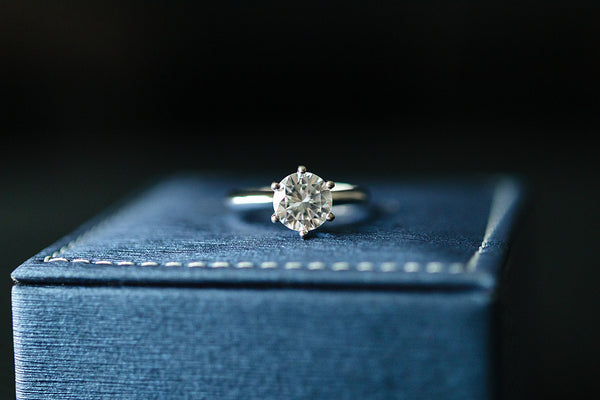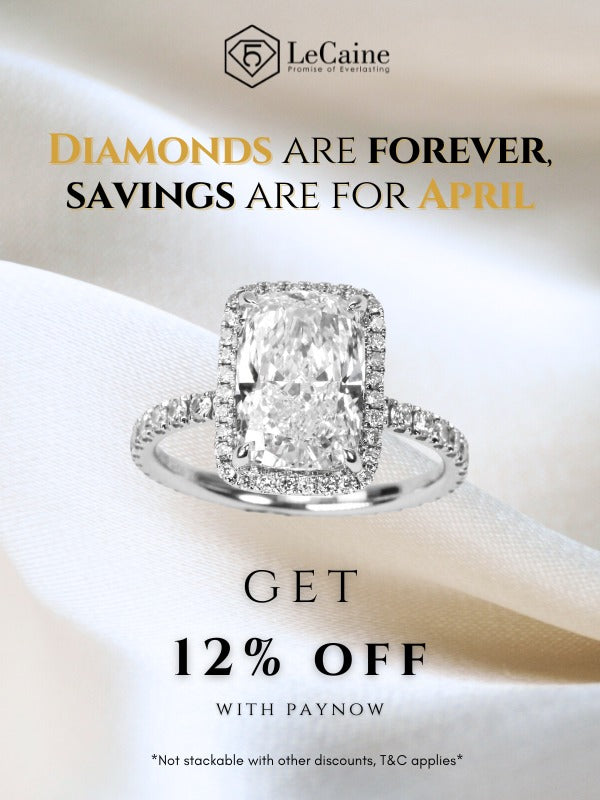- Home
- Engagement Rings
- Wedding & Bridal
- Fine Jewelry
- Custom Designs
- About
- Log in
Get 9 miles/$1 when you purchase in-store with us!
Laying Out the Facts on the 5 Common Diamond Buying Myths
October 07, 2022

Looking at diamonds, evaluating settings, and searching for the perfect engagement ring can be a rather stressful endeavour. Moreover, doing so through online jewelry shops in Singapore can often prove more challenging as there are no experts or sales associates to answer your questions in real-time and help you make the right choices.
By dispelling some of the most common misconceptions surrounding diamonds, this blog post aims to guide you toward a more informed decision so that you can shop with confidence.
1. Blood diamonds are still on the market
Also known as “conflict diamonds”, blood diamonds are those mined via forced labour under terrible working conditions. Consumers became aware of this category of diamonds upon seeing Leonardo DiCaprio’s 2006 film Blood Diamond. However, its depiction of the conflict in Sierra Leone began much earlier than the movie’s release, and the diamond industry established measures against the trade of blood diamonds as early as 2000.
The Kimberley Process is a certification program that came into effect in 2003, which entailed following diamonds in the supply chain from mine to market to ensure that blood diamonds were no longer part of the global diamond trade. Apart from this agreement, established retailers have also taken it upon themselves to set internal rules and regulations to only deal in conflict-free diamonds. In short, you can be confident that blood diamonds are now a thing of the past.
2. Diamonds are unbreakable
Although the saying “diamonds are forever” worked as a tagline for De Beers’ promotional campaign for their diamond engagement rings back in 1947, that doesn’t exactly translate to diamonds being unbreakable. Yes, diamonds are among the hardest of all natural materials, scoring the highest possible on the Mohs hardness scale, but this scale measures an object’s resistance to scratching. In other words, only diamonds can scratch other diamonds. If hit with enough force, any diamond will break. Tenacity is the measure of an object’s resistance to impacts, and like other gemstones, diamonds are of brittle tenacity.

3. The cut grade is insignificant
Virtually all diamonds are graded by the GIA diamond grading system, which assesses a diamond’s quality by its four properties which collectively became known as “The Four Cs”: cut, colour, clarity, and carat. Since the advent of this system, many have debated which of the four is the least and most important from a consumer’s perspective.
Cut generally gets less priority in such debates since colour and clarity are said to be the most obvious properties, and anyone can measure a diamond’s carat weight. In contrast, cut seems too complex a property for most consumers to easily understand. The cut grade of a diamond piece is a measure of how adept the craftsman cut its symmetry and proportions so that it returns as much light to the viewer. The GIA system has established five cut grades: Excellent, Very Good, Good, Fair, and Poor.
While all the Four C’s each deserve careful consideration when it comes to finding the perfect diamond centre stone, experts agree that the cut dictates the overall beauty of a diamond. That should matter to any consumer. Although it is not particularly simple to see a diamond’s exact symmetry of proportions in the same way that you can notice its size or colour, it is fairly noticeable if they are poorly executed.
First-class diamonds with a high cut grade of either Excellent or Very Good dazzle with intense brilliance, balanced scintillation, and fire. E.g., high brightness with strong coloured flashes and white flashes. In contrast, those with poor cuts will look dark and lifeless no matter their colour, clarity, and carat.
At the end of the day, beauty is in the eye of the beholder, and you are the ultimate judge as to what makes a diamond beautiful. Most people have a set budget when shopping for diamonds, so compromising on a lower cut or clarity may be necessary if you prioritise carat or colour. That said, never go for the lowest cut grades (Fair and Poor) as much as possible.
4. Fluorescence is bad
Nearly a third of all-natural and colourless diamonds exhibit a certain degree of fluorescence under longwave ultraviolet light, typically fluorescing with a blue colour. It is essential to know that the GIA lighting standard for grading diamonds is a daylight equivalent with an ultraviolet light component. Therefore, fluorescence is included in a stone’s colour grade.
A diamond’s blue fluorescence could counterbalance its yellowish hues, making it appear whiter or colourless and score a higher colour grade. But what happens when it is viewed under lighting with no ultraviolet component? Will it look yellower?
In reality, there is no noticeable difference in a diamond’s colour in most cases. Most fluorescent stones only show extremely faint or medium fluorescence that has minimal effect on colour. Minute changes in diamond colours are near impossible to detect, even for the experts.
With that said, you may encounter many jewelry manufacturers selling fluorescent diamonds at a lower price due to the common misconception that diamond fluorescence is undesirable. However, do note that unusual diamonds that show strong fluorescence under light without an ultraviolet component may appear cloudy or milky and look much yellower than their colour grade. Unusual diamonds, such as Portuguese cut, will exhibit haziness or cloudy effects.
This is because only 25% to 35% of diamonds fluoresce to some degree when exposed to longwave UV light. These diamonds have a blue fluorescence that exceeds 95%. Rarely do some colours, like yellow or green, glow. This is most apparent in diamonds with high colour grade scores like D, E, and F. As such, be mindful of any stones with intense fluorescence when buying.
5. Lab-grown diamonds are inferior to natural diamonds
There have been countless discussions between natural vs synthetic or lab-grown diamonds and the merits of each from the consumer’s perspective. Both variations share the same chemical, physical, and optical properties, meaning they are exactly alike. So, why are many divided between the two? The sole difference lies in the stones’ origins.
Natural diamonds are formed in the Earth over many years and mined through modern practices. In contrast, lab-grown diamonds are manufactured via man-made techniques that speed up the stone’s creation process and result in stones that can only be discerned from their natural counterpart via specialised equipment. It falls on you, the buyer, to decide how much that difference matters.

Don’t let these misconceptions deter you from your diamond purchase
When shopping for bespoke diamond jewelry, you’re likely to encounter many myths that could affect your purchase decision. Hopefully, the facts stated here put your mind at ease so you can pick out the perfect gift for that special person in your life.
As one of the leading jeweler merchants in Singapore, LeCaine Gems offers exceptional craftsmanship and is the place to go if you’re looking for exquisite and bespoke jewelry. Peruse our immaculate collection of exquisite jewelry pieces, which includes lab-grown diamonds, ethically sourced gemstones, wedding bands, and even Si Dian Jin sets in Singapore. Get in touch with us today or send us a message on WhatsApp at +65 8020 0353 for more details.
Also in Blogs

Lab-Grown & Moissanite Tennis Bracelets: The Perfect Diamond Alternatives
March 29, 2024

Customizing Your Lab-Grown Diamond Ring to Reflect Your Love Story
March 12, 2024




